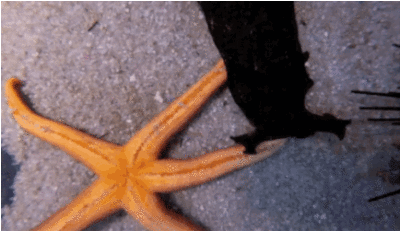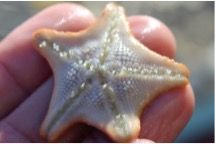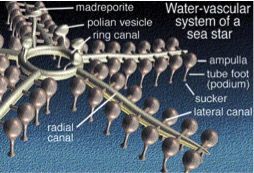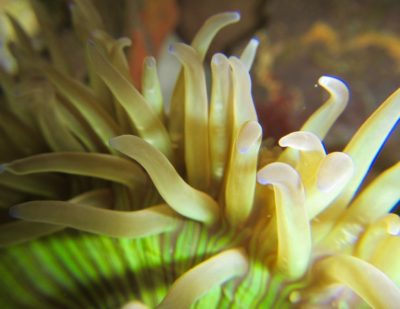
It’s probably without a doubt that during your visit to CIMI you participated in a Sea Star Derby. That’s right, a race of the Stars. A good, old-CIMI-fashioned Sea Star Flip Race! And you probably without a doubt wondered, “how did those sea stars flip back over!?” It’s logical to think that it would be next-to-impossible for those critters to flip back over by themselves if you compare them to an overturned spider or cockroach trying to wiggle its way back right side up. The fact of the matter is, although, they have tube feet.
 You may remember seeing these little guys stringing and slivering out from the body of one of our sea urchins or along the body of that sea cucumber you oh-so passionately smooched in hopes of gaining 7 years of good juju. That’s what those things are! That’s what helps our little sea star friends flip themselves back over whenever they get overturned or take part in a race.
You may remember seeing these little guys stringing and slivering out from the body of one of our sea urchins or along the body of that sea cucumber you oh-so passionately smooched in hopes of gaining 7 years of good juju. That’s what those things are! That’s what helps our little sea star friends flip themselves back over whenever they get overturned or take part in a race.
Now…because we’re all inquisitive scientists here, you’re next question is most likely, “Well, how do they work?” Well, lets investigate!
Sea Stars, and all echinoderms for that matter, move around using tube feet. Hundreds of these little guys inhabit the undersides of their limbs, working to chug their bodies along the sandy and rocky bottoms, grab food, as well as see. Surrounding water is taken in by a sea star through a special hole, called a madreporite.  Water is then flushed throughout their bodies using a special water-vascular system, which is made up of a series of canals that radiate from the central disk into the outer extremities. The water gets stowed away all along the sea star’s arms within storage sacs, called ampulla, of which are connected to the tube feet. When the sea star is ready to make a move, the ampullae, with the help of muscle contractions, squeeze water into the tube feet causing them to inflate and extend. The pressure created by the water being pushed into the tube feet keep them extended until coming in contact with a surface. Additionally, suction cups located at the exterior ends of the feet allow for successful attachment to surfaces, as well as food. When the tube feet are ready to release, the muscles within the ampullae relax as water gets drawn out. This process continues to repeat itself as water continuously flows in and out of the body.
Water is then flushed throughout their bodies using a special water-vascular system, which is made up of a series of canals that radiate from the central disk into the outer extremities. The water gets stowed away all along the sea star’s arms within storage sacs, called ampulla, of which are connected to the tube feet. When the sea star is ready to make a move, the ampullae, with the help of muscle contractions, squeeze water into the tube feet causing them to inflate and extend. The pressure created by the water being pushed into the tube feet keep them extended until coming in contact with a surface. Additionally, suction cups located at the exterior ends of the feet allow for successful attachment to surfaces, as well as food. When the tube feet are ready to release, the muscles within the ampullae relax as water gets drawn out. This process continues to repeat itself as water continuously flows in and out of the body.
Now, whether it’s a Brittle Star or Bat Star, either or will curl the tips of their arms using their tube feet and turn themselves back over. The faster one of the two to do that? Well, you’ll just have to try it out the next time you are reunited with some sea stars…..or just watch the video.
May the odds be ever in your favor!
Written by John Cornett
Internal Sea Star Anatomy – http://www.asnailsodyssey.com/IMAGES/SEASTAR/WatVasc.gif


